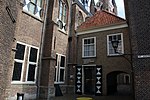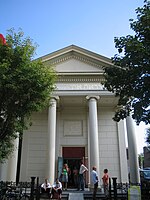Saint Hippolytus Chapel, Delft

The Saint Hippolytus Chapel (Dutch: Sint-Hippolytuskapel) is a chapel in the old city of Delft. It is one of the oldest buildings in Delft, and since 1967 it has been designated the Rijksmonument.The church was built around 1400 in the Gothic style and is located on the east side of the Oude Deft. Until the Reformation, the Oude Kerk was consecrated to Saint Hippolytus, and the name of the chapel comes from the city quarter. At the time of foundation, it was a part of the already existent female religious community, similar to a monastery - Holy Spirit Sisters House (Dutch: Heilige Geestzusterhuis). It was built on the foundations of the older chapel and was consecrated in 1412. In 1536, it was badly damaged by a fire and subsequently restored. In 1572, during the Reformation, the interior of the chapel was emptied, and the clock and the cross were taken from the tower. After 1581, it was used as a depot, but a part of the chapel was still used for service by Protestants.In 1910, the chapel was restored, and the design of the facade was altered, making it to look more like the original design. Since 1924 and until the construction of the new campus of Delft University of Technology in 1966, the doctorate ceremonies of the university were held in the chapel. In 1972, it was transferred to the Roman Catholic Church and since 30 July 1972 is used for service.
Excerpt from the Wikipedia article Saint Hippolytus Chapel, Delft (License: CC BY-SA 3.0, Authors, Images).Saint Hippolytus Chapel, Delft
Oude Delft, Delft
Geographical coordinates (GPS) Address External links Nearby Places Show on map
Geographical coordinates (GPS)
| Latitude | Longitude |
|---|---|
| N 52.011209 ° | E 4.356608 ° |
Address
Sint Hippolytuskapel
Oude Delft 118
2611 CG Delft
South Holland, Netherlands
Open on Google Maps










